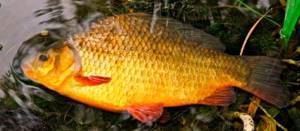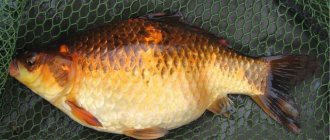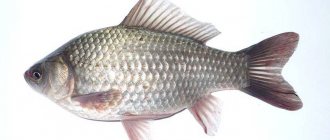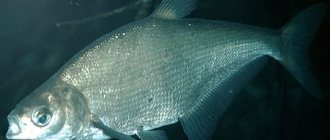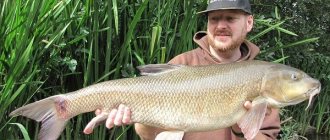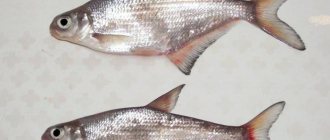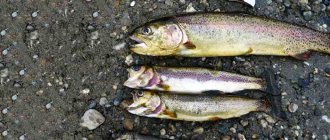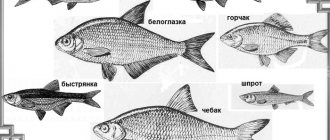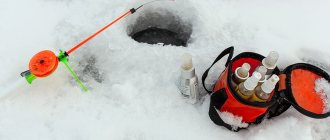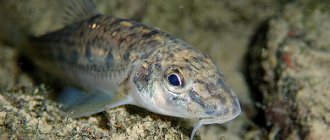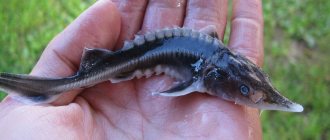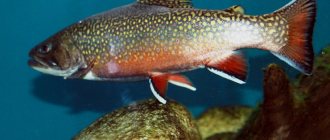Description of goldfish
Golden (common) crucian carp has the following biological features:
- The length of the body depends on the nutritional value of the food in the river, lake or other body of water where it lives, and can reach a maximum of 50 cm. In this case, an adult individual gains a weight of 4–5 kg.
- The body is tall, 1.2–2 times less than its own length, strongly flattened laterally.
- The color of the back is dark, sometimes with a brown tint or a green tint, the peritoneum is light, the sides are dark golden. There are some orange specimens.
- The scales are dense, large, closely adjacent to the skin, with about 32–35 scales located on the lateral lines.
- Fins: dorsal - long, directed backwards, caudal - slightly dimpled, paired - red.
- The small mouth is filled with single row pharyngeal teeth.
- The average life expectancy is 7–10 years.
This type of fish is characterized by significant ecological plasticity. In habitats with poor nutrition, dwarf forms with a large head and tall body grow. They have a low growth rate, however, maturity occurs very quickly. The fish is hardy and unpretentious to water. Survives in bodies of water with a low dissolved oxygen content of 0.5 to 0.6 cubic meters. cm/l.
Did you know? Golden crucian carp was first brought to Russia in the 17th century. Fish were bred in the royal ponds.
What does it look like
In appearance, these fish are more similar to carp, but they are distinguished from it, as from carp, by several characteristics:
- absence of a mustache near the mouth;
- taller body;
- structure of pharyngeal teeth.
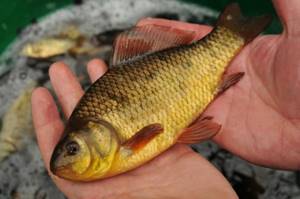
Externally, the golden subspecies has a more rounded and wider body shape than the silver one.
Characteristics
These fish are characterized by a slowdown in growth if they begin to densely populate a reservoir during the breeding process. C palm is the maximum value that can be in such conditions. During spawning, females emerge from almost all of the laid eggs. During the entire breeding period, females lay eggs in portions of 3–4 batches.
Read how crucian carp differs from carp and other fish.
The water temperature should be at least +18°C and the vegetation depth should be about 0.5 m. They feed actively early in the morning and late in the evening. The age of an individual can be determined by the number of rings on its scales. They grow very slowly. Specimens of 5 kg are a real trophy, since they gain such weight after 10 years of life.
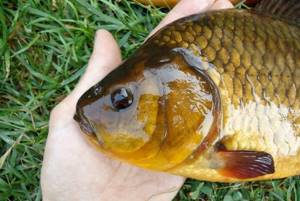
Appearance of golden carp
The genus of crucian carp is one of the most flexible and changeable among all aquatic animals. These fish easily change their size and shape depending on external conditions. They are easy to hybridize, which is why several varieties of golden crucian carp are found in nature, including hybrids with the silver subspecies. The genus is divided into 3 types:
- Golden (common) - Carassius carassius.
- Silver crucian carp - Carassius gibelio.
- Goldfish - Carassius auratus.
The first type can have a high and low body. The tall-bodied form (often called the humpback fish) is formed when the fish lives in waters rich in food. If living conditions are favorable, crucian carp reaches large sizes (sometimes up to 40-50 cm), and its dimensions are such that its height is almost equal to the length of the body. Sometimes such a fishing trophy is called round crucian carp. In reservoirs where the food supply is scarce, a low-bodied dwarf form is formed.

An endless number of crucian carp breeds have been bred under artificial conditions. These are telescopes, koi, comets, lionheads, shubunkin, pandas and others. They all differ in color, body shape, head, eye size and fin configuration.
How is it different from silver
Silver crucian carp is similar in physique to gold carp, but differs in color. Its scales are silver-gray. The muzzle is slightly more pointed when viewed in profile. The scales of the golden variety are colored golden with an olive tint. Sometimes the color reaches bronze with a red tint and then the fish is called red crucian carp. This fish has orange-reddish fins on the belly and under the gills, while the belly is yellowish, with no yellow tint on the dorsal and caudal fins.
Where is it found?
A subspecies of the Karpov family with golden scales lives in Siberia and the European part of Russia, capturing the waters of the Lena River. Loves overgrown reservoirs with silty soils. Often inhabits wetlands with acidic water, floodplain and forest lakes. Adapts well to polluted rural ponds where other fish species cannot survive. In general, goldfish prefer stagnant water, which is well warmed up by the sun's rays during the day. You can rarely find it in clean ponds or rivers with a sandy bottom.
Important! The richer the food in the habitats of common crucian carp, the faster its growth and development rate.
What is caught in reservoirs
Ogudnevo fishing is offered on a paid basis both in wild and specially equipped places.
For fishermen there is a considerable selection of various fish:
- trout,
- perch,
- carp,
- beluga,
- carp,
- sturgeon,
- roach,
- pike,
- som,
- Lin and many others.
The reservoir is regularly stocked with fish, and a high density of fish is the key to successful biting.
As bait, you can use any option most preferred by fishermen. There is a shop offering various types of bait for vacationers. Experienced instructors will provide qualified assistance to beginners in their choice. For those who came just to relax and feel the urge to fish, fishing equipment is offered for rent.
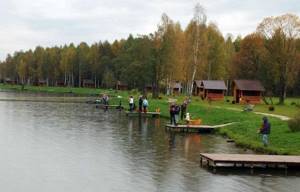
Fishing in the Shchelkovo region is carried out temporarily under a promotion without a catch limit, but the rest of the time the norm is set for each individual type of fish.
What does it eat?
The usual diet of a representative of the Karpov family includes:
- detritus;
- small crustaceans;
- plankton;
- seaweed;
- chironomid larvae;
- worms;
- remains of aquatic plants;
- insect larvae;
- invertebrates.

The intensity of feeding directly depends on the season. In summer, young animals and adults feed actively.
Methods of catching crucian carp
Golden crucian carp is a less common species among crucian carp. Many ways have been invented to catch it. The most popular are feeder donka, float tackle, winter and summer jigs.
Catching crucian carp using feeder gear
Crucian carp can be caught with the simplest gear, but when fishing from the bottom you should give preference to a feeder. These are “bottom” equipment, most often using feeders. The feeder and picker are convenient for most, even inexperienced anglers. They allow the fisherman to be quite mobile on the pond, and thanks to the possibility of targeted feeding, quickly “collect” fish in a given place. Feeder and picker, as separate types of equipment, currently differ only in the length of the rod. The basis is the presence of a bait container-sinker (feeder) and replaceable tips on the rod. The tips change depending on the fishing conditions and the weight of the feeder used. Fishing baits can be of any kind: both plant and animal origin, including pastes. This fishing method is available to everyone. The tackle does not require additional accessories and specialized equipment. This allows you to fish in almost any body of water. It is worth paying attention to the choice of feeders in shape and size, as well as bait mixtures. This is due to the conditions of the reservoir (river, pond, etc.) and the food preferences of local fish.
Catching crucian carp with a float rod
For several centuries now, numerous articles have been published with recommendations for catching this fish. The float rod remains the most popular equipment for catching this fish. The main criteria for choosing gear are related to the desires of the fisherman and a particular body of water. Due to the way of life of crucian carp and fishing conditions, anglers have problems catching them (frequent loss of equipment). This is due to the fact that sometimes the fish becomes “very capricious”, and fishermen try to get out of the situation by making the gear as thin and neat as possible. The problem has no specific solution. In different conditions you need to approach based on the need and capabilities of the fish. One thing can be said with certainty: when fishing in reservoirs with difficult terrain and fishing conditions, it is better to use gear that can be described as reliable. When catching many carp fish, the basis of successful fishing is baiting, groundbait and bait. Crucian carp in this case is no exception. The second factor for successful fishing is the choice of time and place of fishing. The most accurate information on a specific body of water can be provided either by local fishermen or fish farm owners.
Catching crucian carp with other gear
Crucian carp can be caught in different ways. Starting from traditional “donoks”, “zakidushki”, “rubber bands” and other things to complex ones - fly fishing. The fish stubbornly resists, which brings a lot of pleasure to the angler. Crucian carp responds well to baitless jig fishing rods both in winter and summer gear. In most crucian carp reservoirs, fish are caught from ice at the beginning and end of winter.
Lifestyle
This is a unique subspecies that survives in the most unfavorable conditions. It is characterized by high vitality. For the winter it burrows into the silt, where it remains until spring without movement or food. In shallow reservoirs where the water freezes strongly, it does not die, even when it freezes into ice, if the internal fluids of the body and blood do not freeze.
Can tolerate drying out of reservoirs in the summer season and constant low water temperatures. However, under these conditions it stops reproducing. It emerges from its winter refuge in the spring only when the ice has completely thawed and the water has warmed up. In general, it leads a sedentary lifestyle and does not make any long-distance migrations; it is a very tenacious fish.
Did you know? Crucian carp can be classified as substance abusers, since they are greedy for inedible aromas and harmful products. For example, they are attracted by the smells of kerosene, drops of valerian and Corvalol.
Silver fish
The body color of this extraordinary fish is light gray with a metallic tint. The back is a little darker. The shape of the silver crucian carp is more oblong than that of its golden relative. Since young fish are in no way inferior in size to adult fish, their distinctive feature is their scales. In adult waterfowl, the cover is thicker and rougher. To keep crucian carp in an aquarium, it is recommended to purchase small fish.
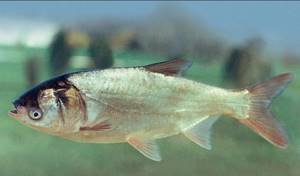
The fish is the most undemanding to care for. Even for spawning, it requires a water temperature of no higher than 14 degrees. These are very cold-loving creatures. For wintering, the temperature of the water in the container should not exceed 8 degrees. In such an environment, pets hibernate and do not eat.
Reproduction
An adult reaches sexual maturity at 2–4 years under favorable conditions. Males mature faster than females. 30–400 thousand eggs mature in the abdominal cavity of the fish. They begin to spawn in late May-early June, at a water temperature of +13...+14°C.
During breeding, adult individuals gather in small flocks and go into aquatic thickets. They stay there for 2–3 days while the process itself lasts. The female lays eggs in portions, 10–100 thousand eggs each. The caviar is light yellow, one unit in diameter is 0.8–1.1 mm. It sticks to algae and plants that are in the water. The incubation period lasts 5–7 days.
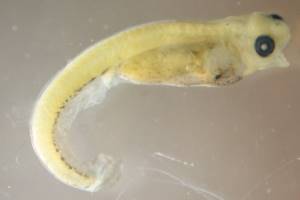
From the eggs, fish larvae emerge, which cling to the underwater parts of plants with special glands. They remain in this state until the yolk sac is completely reabsorbed.
The development of the embryo and larvae of common crucian carp can take place even with a lack of oxygen in the water. This happens thanks to a well-developed respiratory system, which is highly adaptive to unfavorable conditions.
Where to catch crucian carp.
We have been fishing for many years, but we still cannot understand the logic behind the activity of crucian carp. You can catch a lot of fish one day, but return to the same place the next day and not see a single bite at all. Of course, this happens with other types of fish, but crucian carp is something special about the capriciousness of fishing. Only on the basis of where there is an overpopulation of crucian carp can we talk about guaranteed success in fishing. However, in these areas, in turn, it is very difficult to expect large samples - more than 1 kg.
Of course, there are several areas where such mining can be assumed. In most cases, they have warm lakes with a large number of large predatory fish that knock out small crucian carp. Thus, it is more likely to find golden crucian carp in some hidden lakes located far from populated areas and hidden in hard-to-reach places.
You can also bet on small, isolated shallow bodies of water, but there is a 1:10 chance that you will find goldfish there. Most likely, you will come across its hybrid, in particular the silver crucian carp. Interestingly, typical small backwaters are not suitable for fish such as bream, roach and carp, as there is very little food for them.
Apparently goldfish can use other food sources and, most importantly, there are periods that are less favorable for other types of fish, for example, extreme heat. Also remember that goldfish can survive winters when the water freezes to the bottom (I'm no expert, but I heard somewhere that crucian carp can produce oxygen from their fat reserves).
I’ll tell you one case that amazed me about the vitality of crucian carp. Once I received crucian carp from a friend in several small plastic bags. I thought they were dead (they had been without water for a long time and did not move). I put the bags of fish in the refrigerator. The next day I would like to use them to catch pike perch. Arriving fishing, so that the fish would not spoil ahead of time, I filled a bucket with water from the lake and poured the crucian carp into it. What was my surprise when after a while, almost all the individuals came to life and began to swim in the water. They were more than 24 hours without water!
Fishing Features
Golden crucian carp can be found in lakes remote from populated areas. The further away and more inaccessible the place, the greater the chances of catching a good catch. The best fishing for small and medium-sized fish is close to the shore (2–3 m).
We also suggest studying the features and recommendations for catching crucian carp in windy weather.
Fishing for this species of Karpov representatives has some features:
- The fish bite well in shallow areas of the reservoir, where there is a muddy bottom or a lot of mud. Aquatic vegetation should be present, preferably reed thickets, gaps between algae.
- Common crucian carp is in constant motion, therefore, having caught a dozen fish, it is necessary to move to another place and re-feed.
- Maggots, insect larvae, and dung worms work great as bait. It is good to catch large specimens using peas or corn (canned or boiled). It is better to add food of animal origin to complementary foods. You can use the classic method of fishing for cake and feed with a bottom mixture for bream or carp.
- Fishing gear. The most common tool is a fishing rod with a float. The fishing line is selected with a thickness of 0.16–0.20 mm with a thin leash of 0.12 mm. Hooks should be white No. 10–14. If a fisherman prefers long-cast fishing, a suitable fishing rod is a telescope with a 5–6 m long reel and a removable float. It is necessary to use sinkers that are secured from the hook at a distance of 25–30 cm. You can fish with gear with two leashes up to 0.14 mm thick, the length of which is 15 cm, and the main line should be no thicker than 0.24–0.30 mm.
- Features of the bite. Adults are very careful and can pretend to bite for a long time. In wild places, fish bite sharply with a running start. The golden subspecies is stronger than the silver one and can cut the line with its dorsal fin at the moment of the flip, so you should not loosen the line on the fishing rod.
- All individuals have small and weak mouths, so the catch must be brought to the landing net carefully. The main thing when fishing: do not let the fish go into the thickets of grass and reeds, and also keep the line always in tension.
If there is a bad bite, you should loosen the equipment as much as possible and place small bait on the hooks. It is necessary to choose the thinnest leashes for fishing areas where there is practically no vegetation in the water.
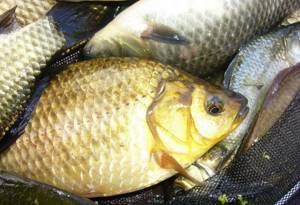
Active fishing for crucian carp using nets or other gear is carried out during spawning periods.
"Karasevy" pond
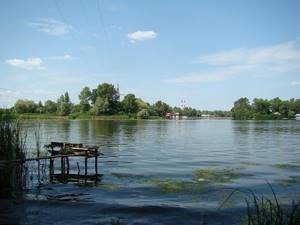
The exceptional resistance to periodic lack of oxygen and the high birth rate of crucian carp is the reason that it can be caught in river bays and oxbow lakes, in drainage ditches, as well as lakes, ponds, quarries, field and forest lakes, and can be found in abandoned peat mines You can have this strong but capricious fish. There are bodies of water where no other fish other than golden-bellied fish simply can survive. In these places, crucian carp is the only fish that can save a fisherman from depression.
Usually, most fishermen associate the concept of a “crucian carp” reservoir with such small bodies of water. The golden-bellied can survive almost anywhere where the water does not dry out in summer and the depth reaches fifty centimeters. Yes, in such a reservoir it is difficult to find crucian carp more than ten centimeters long and weighing more than one hundred grams. Large crucian carp is a resident of large reservoirs, where its life is an eternal struggle with food competitors and predators.
Unlike bream and tench, crucian carp rarely reveals its presence in a reservoir. There are only minor, unnoticeable signs of the presence of crucian carp to the inexperienced eye.
These are visible signs of fish feeding. Somewhere the water suddenly becomes cloudy, fragments of bottom vegetation float to the surface along with air bubbles. And, most often it is discovered on a fine sunny day, when the sun shines through the entire thickness of the water, right to the very bottom. You are standing on the shore at this moment and see a huge flock lazily moving its tails in the warm, clear water. And then you begin to understand that the reservoir is populated.
Fishing for crucian carp in a silted reservoir A thick layer of silt at the bottom of lakes and backwaters with standing water creates considerable problems for anglers, because bait and bait settle and sink into the bottom sediments and become inaccessible to fish. But it is precisely in such silted places that the “coveted trophy” – large crucian carp – is kept...
What is the difference between golden carp and silver carp?
The main differences between representatives of the Karpov family - gold and silver crucian carp - are as follows:
| Signs | Gold | Silver |
| Color | golden shades, sometimes with a copper-red tint | gray-silver, green-gray |
| Scales | large, with 32–35 scales along the lateral line | 28–31 scales on the lateral line |
| Head shape | rounded | slightly pointed, elongated |
| Dorsal fin edge | convex, looks hunchbacked | concave inward |
| Weight | gains slowly (100 g by three years) | grows quickly (1 kg in 3 years) |
| Gill rakers on one arch (pcs.) | 39–50 | 23–35 |
| Branched rays on the anal fin (pcs.) | 6 | 5 |
| Number of vertebrae (pcs.) | 31–34 | 29–31 |
| Body | tall, thick round back | angular body shape, the back is often compressed laterally |
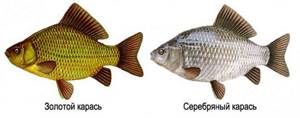
Both species have a non-branched, powerful ray with a jagged edge on the anal and dorsal fins. The silvery species is more tenacious and recently it has been increasingly displacing golden crucian carp from reservoirs in numbers.
Did you know? The largest crucian carp was caught weighing 4.25 kg in the Turukhan River (the left tributary of the Yenisei).
In general, these two subspecies of the Carp family have many similar biological characteristics, however, they also have their own characteristic features. Each of them is characterized by differences in appearance, habits, fishing habits, etc. All varieties are ecologically flexible and survive in difficult conditions where other fish species die.
Appearance (external structure).
Fish of the genus Carp are distinguished by a short, high body, slightly compressed from the sides. Golden crucian carp, unlike silver crucian carp, has a relatively small head.
The mouth is finite, the crucian carp has no antennae, and has medium-sized scales. On the back there is one high dorsal fin with a rounded edge. The caudal fin of the goldfish has a small notch. The last unbranched rays of the fins on the back and near the tail are in the form of jagged spines.
The general body color of the copper-golden back is brownish. The ventral side may be yellowish or grayish.
Unlike silver crucian carp, golden crucian carp does not have a pigmented peritoneum (“internal” dark color of the peritoneal cavity).
